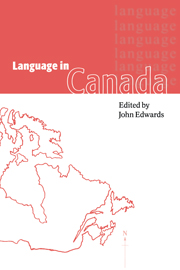Book contents
- Frontmatter
- Contents
- List of figures
- List of maps
- List of tables
- Notes on contributors
- 1 Canada
- Introduction
- 1 The foundations
- 2 The fading Canadian duality
- 3 Official bilingualism: from the 1960s to the 1990s
- 4 Official multiculturalism
- 5 Language in education: bridging educational policy and social psychological research
- 6 Aboriginal languages: history
- 7 Aboriginal languages: current status
- 8 French: Canadian varieties
- 9 French in Quebec
- 10 French in New Brunswick
- 11 French outside New Brunswick and Quebec
- 12 English: Canadian varieties
- 13 English Quebec
- 14 The teaching of international languages
- 15 French immersion in Canada
- 16 Language in Newfoundland
- 17 Language in Prince Edward Island
- 18 Language in Nova Scotia
- 19 Language in New Brunswick
- 20 Language in Quebec: aboriginal and heritage varieties
- 21 Language in Ontario
- 22 Language in Manitoba
- 23 Language in Saskatchewan: Anglo-hegemony maintained
- 24 Language in Alberta: unilingualism in practice
- 25 Language in British Columbia
- 26 Language in the Northwest Territories and the Yukon Territory
- Index of names
- Index of language families, languages, dialects
- Index of subjects
26 - Language in the Northwest Territories and the Yukon Territory
Published online by Cambridge University Press: 18 February 2010
- Frontmatter
- Contents
- List of figures
- List of maps
- List of tables
- Notes on contributors
- 1 Canada
- Introduction
- 1 The foundations
- 2 The fading Canadian duality
- 3 Official bilingualism: from the 1960s to the 1990s
- 4 Official multiculturalism
- 5 Language in education: bridging educational policy and social psychological research
- 6 Aboriginal languages: history
- 7 Aboriginal languages: current status
- 8 French: Canadian varieties
- 9 French in Quebec
- 10 French in New Brunswick
- 11 French outside New Brunswick and Quebec
- 12 English: Canadian varieties
- 13 English Quebec
- 14 The teaching of international languages
- 15 French immersion in Canada
- 16 Language in Newfoundland
- 17 Language in Prince Edward Island
- 18 Language in Nova Scotia
- 19 Language in New Brunswick
- 20 Language in Quebec: aboriginal and heritage varieties
- 21 Language in Ontario
- 22 Language in Manitoba
- 23 Language in Saskatchewan: Anglo-hegemony maintained
- 24 Language in Alberta: unilingualism in practice
- 25 Language in British Columbia
- 26 Language in the Northwest Territories and the Yukon Territory
- Index of names
- Index of language families, languages, dialects
- Index of subjects
Summary
INTRODUCTION
The northern part of Canada still holds a special mystique for many people. It is often thought of as a frozen frontier awaiting development, inhabited by only a few hardy individuals who suffer at the unkind hands of the elements, eking out a meagre living. In fact, there are many developments in this region that are envied by people in other parts of Canada and the world. At the same time, some major issues still need to be addressed. This chapter identifies both accomplishments and challenges related to the languages of the north.
It is perhaps because the north has only recently begun to develop the type of institutions that Europeans and southern Canadians have known for generations that there is greater opportunity for innovation. In addition, Canadians have, fairly recently, achieved a new awareness about the linguistic and cultural diversity of this country, and about the contributions made by aboriginal people. Further, because the Northwest Territories (NWT) will be divided into Nunavut and a separate western territory in 1999, and because aboriginal people in the north are beginning to settle their claims and establish their own forms of self-government, northern residents find themselves facing the enormous responsibility of recreating every aspect of society.
- Type
- Chapter
- Information
- Language in Canada , pp. 469 - 482Publisher: Cambridge University PressPrint publication year: 1998



